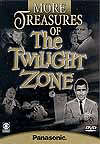Treasures Of The Twilight Zone
Panasonic
Cast:
Extras: Rod Serling interview, Rod Serling Sponsor Pitch Video, Season highlights and episode info, Cast info and series history
Rating:
"Treasures of the Twilight Zone" and "More Treasures Of the Twilight Zone" present three episodes per disk that show just how good it could be. They are a good sampling of what made Zone special, and what could also make it controversial. Treasures includes the pilot episode "Where is Everybody," the rarely seen "The Encounter," and the "non-Zone" Zone episode "An Occurrence at Owl Creek Bridge" (more on this later). More Treasures includes "The Masks," "Eye of the Beholder," and "The Howling Man." All six would place in the top ranks of the best episodes in the series, and are well-deserving special DVD treatment.
As the episode that sold the series, "Where is Everybody" set the tone but also shows Serling pulling his punch. The story centers around actor Earl Holliman’s growing panic as he wanders about a town that seems just recently abandoned. A taught script, solid performance, and score by Bernard Herrmann make this a little gem of television. The only slight let-down is the ending. Where Serling’s trademark twist endings would often involve a supernatural or ambiguous explanation, he was obviously afraid that would be too much to sell the series. Instead, he offers a more conventional twist in the pilot that doesn’t quite do justice to the preceeding drama.
Once the series was sold, Serling stopped pulling his punches and began taking more serious chances, as the other two rarely seen episodes on this disk prove. The real gem is "The Encounter," which was deemed so controversial that it was never broadcast again and was left out of the syndication package. A tight, two-character, one-set drama, "The Encounter" casts Star Trek’s George Takei as a young Japanese man and veteran tough guy Neville Brand as a Pacific War veteran with a Samurai sword. The drama is so racially charged and disturbing that it’s clear why controversy-averse programmers of the 1960s decided not to show it again. The performances, particularly Takei’s, do justice to one of the best Zone scripts ever produced.
This is a real lost gem, and shows just how perfectly the series could blend entertainment and social commentary.
The second disk has none of the rarities of the first, but does contain three more excellent and popular episodes. "The Masks" is about a dying man, who makes his greedy heirs wear masks that reflect their inner nature. "Eye of the Beholder" (often voted the most popular episode by fans) involves a woman undergoing plastic surgery to look "normal." Finally, there’s the Charles Beaumont-scripted "The Howling Man": a stylish episode in which a group of monks may or may not be holding the devil captive. While these three are frequently seen in syndication, they are still classics of the series, and are well-worth having for fans.
The true highlights are in the "Rod Serling" extras. They include the aforementioned interview with Mike Wallace and a "pitch movie" made for sponsors. The interview is almost 25 minutes long, and though the quality of the source material is poor, the content is fascinating. The technical quality of the original pitch movie is equally poor, but again well-worth it for a fascinating insight into how a major personality like Serling had to shill his cutting edge new show for a bunch of product pitchsters. It lasts about ten minutes, as Serling walks us through several of the stories in the first season and promises advertisers a big audience. Episodes also have Serling "teasers" for the next week’s show.
The problem? The extra section has been repeated identically on both disks, right down to the episode-specific information. This means there are no credits or background info for the three episodes on the second disk, since the producers inadvertently simply copied the episode guide from the first. The text also scrolls automatically, just a bit too fast to read, without any way to pause or move backward through the text.
Panasonic has more Zone disks on the schedule, each with three more episodes. The production and transfer quality, as well as the fascinating extras, are strong enough to make these models for transferring TV shows to DVD.







